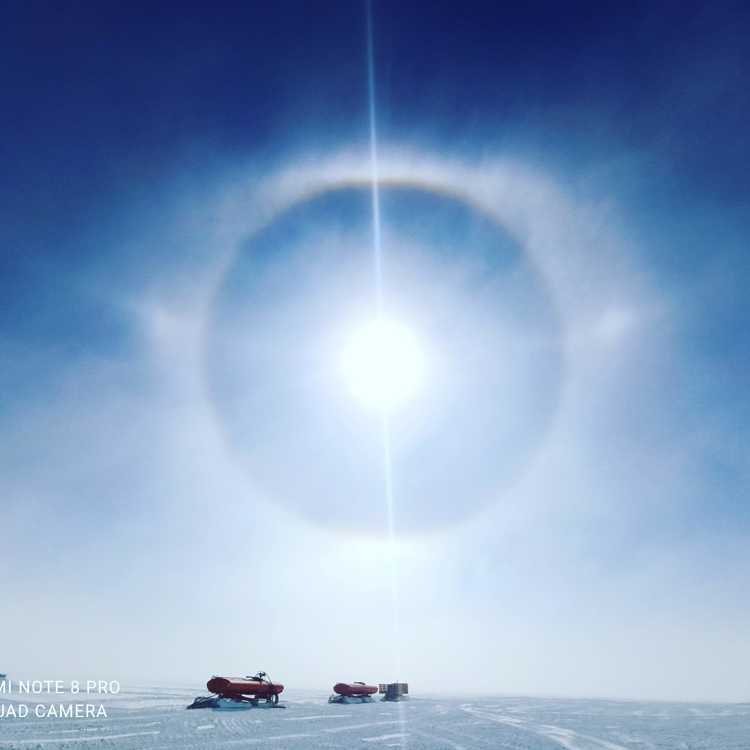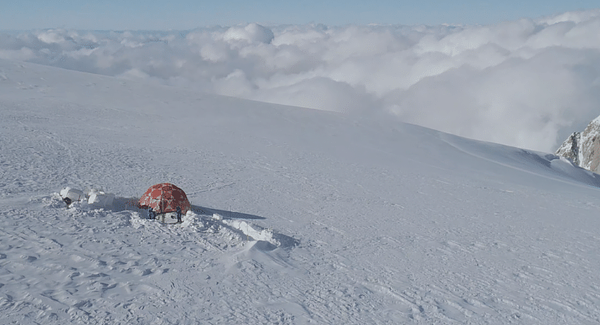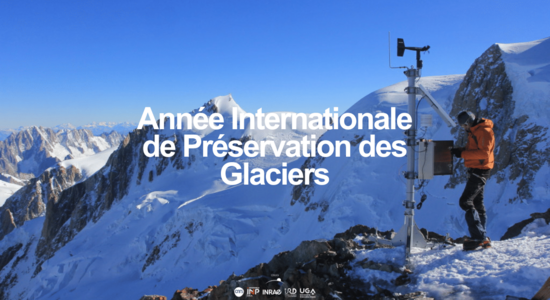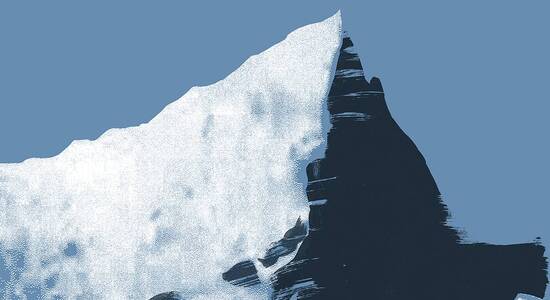Beyond EPICA Oldest Ice - Field Diary - Carnet de terrain
Publié par Institut des Géosciences de l'Environnement IGE, le 28 janvier 2022 2.5k
Article en français ci-dessous
Welcome to Antarctica! Discover the backstage of the scientific project Beyond EPICA with the day-to-day life of the team in the field.
Article by Ailsa Chung, PhD student at the Institute of Environmental Geosciences
Photo: Sun halo at Little Dome, Philippe Possenti
The aim of the Beyond EPICA drilling project is to study the evolution of temperatures and the composition of the atmosphere 1.5 million years ago, by analysing ice cores which will be extracted from the deep ice of Antarctica.
By studying this ice we hope to learn more about the Mid-Pleistocene Transition (MPT) which 0.7-1.25 million years ago. The transition was from relatively stable glacial cycles of 41,000 yrs, to cycles asymmetric cycles of 100,000 yrs on average. These asymmetric cycles are very different as they have long cooling cooling periods followed by a comparatively rapid warming period. Studying the MPT will advance our understanding of the many factors which affect our climate and how it may behave in the future.
The team in Antarctica, currently working on this is composed of scientists engineers and technicians from across Europe. Among the team there are 4 people from IGE, Grenoble at the moment: Olivier Alemany, Romain Duphil, Philippe Possenti , Gregory Teste. While their main aim in Antarctica this season is to start drilling the ice core, there are many other tasks they have to do to set up the Little Dome C (LDC) drill site.
In order to conduct fieldwork in Antarctica, the team not only needs their scientific instruments but also equipment for energy, storage, and living in the freezing temperatures. It is an immense task transporting so much equipment to this remote corner of the world. A convoy of 208 tons of cargo travelled 1100 km in 10 days from the Antarctic coast to the Concordia station (around 40 km from the Little Dome C drill site) and required 10 people to manage. This is only one of multiple convoys on this scale.

Large convoy consisting of 3 units pulled by 2 Caterpillars each, with 27 sledges in the trail. Photo: T. Stocker
Once everything has arrived at the station, it must be set up by electricians, engineers and technicians. Power lines had to be installed in trenches in order to heat the sleeping tents. A large antenna for broadband communication will allow the team to more easily communicate with their colleagues in Europe and with their families. The team must even melt snow for the production of fresh water at the station!

Installation of the satellite dish within a protective hull for broadband. Photo: T. Stocker

Olivier and Anthony working hard that all activities have power. Photo: T. Stocker
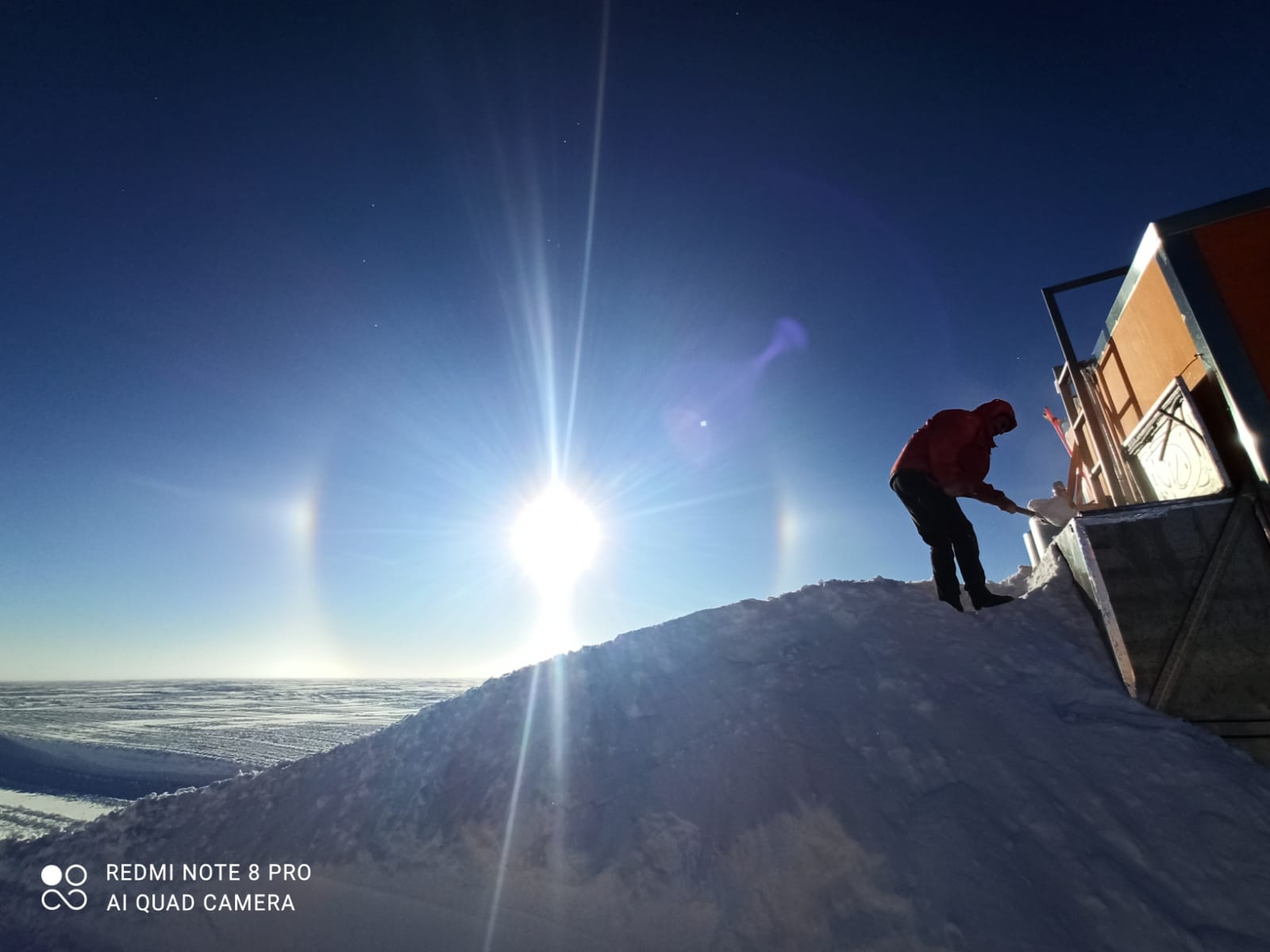
One of the drillers collecting snow so it can be melted for fresh water. Photo: Philippe Possenti
On 4 Dec, the long awaited drilling at LDC began. Assembling the drill took the team 3 days in temperatures below -60°C. In 4 days, the drillers had reached a depth of 128 m. This is the bottom of the “firn”, which is the depth at which the snow, which has been compressed over 1000s of years, becomes solid ice.

Beyond EPICA team holding the first core and marking the opening of the drilling. FLTR: Pauty (IPEV), Teste (IGE), Scalet (ENEA), Panichi (ENEA), Delanoe (IPEV), Monaco (ENEA), Possenti (IGE), Hüther (AWI). Photo: A. Pauty
Once the team drilled to this depth, the hole needed to be enlarged and reinforced with casing. The casing insures that when drilling liquid is pored down, it is not lost to holes in the firn. It also stops the drill hole from closing when it is left between seasons and prevents damage when the drill is removed. Below is a photo of Olivier working at the bottom of the drill trench where temperatures are about -55°C! When working in such conditions, particular attention must be paid to exposed skin (nose tip, cheeks close to sun glasses, etc.) as these parts can get cold very quickly. If exposed for too long, the consequences are felt for several weeks after (drillers confirm this from experience)!

Olivier working in the most extreme working conditions available at Little Dome C. Photo: T. Stocker
Living in Antarctica
When there is fault, everything must be fixed by those on site. One day when the team woke up, one of the generators was broken, took most of the day to get it back up and running. Here is how they dealt with it.
13 Dec 2021
Over the night the winds picked up considerably, and the entire morning and most parts of the afternoon we experienced high winds of about 23 knots. At a temperature of T = −28°C the perceived temperature was below −50°C – hardly bearable. Work outside was not possible and so progress today was essentially limited to work in the drilling tent. The high wind even affected our two heaters in the recreation tent. When the first of the team arrived for breakfast, they found a rather chilly tent as one of the petroleum ovens quit working overnight. However, Calogero (ENEA)
and Michele (ENEA) fixed them so that by dinner, the tent was very warm.
25 Dec 2021
The team may be in Antarctica to work but there is still time to celebrate Christmas with a spectacular 7 course dinner prepared by Saverio (ENEA) and his assistants (Calogero and Philippe)
Cozze gratinate, Capesante al forno, Salmone affumicato, Gamberetti ai ferri, Insalata di polipo e patate, Zuppa di Pesce, Gamberoni al cognac. Drinks started with Champagne and Aperol Spritz, Burgogne Aligoté, and Caffè, and for desert: Zanzibar Torrone and Cannoli scomposti.

The LDC-BEOIC Team after a sumptuous Christmas Dinner. Photo: C. Barbante
So far this season, things have been progressing well at the station. More updates to follow!

Drone view from Little Dome C from South East
About Beyond Epica
The French Polar Institute and its Italian partner, the PNRA, are making an essential contribution to the logistics of setting up the programme and hosting the scientists thanks to their own resources and staff.
Extra resources:
- An article in Le Dauphine Libéré
- A podcast
---------------------------------
Bienvenue en Antarctique ! Découvrez les coulisses du projet scientifique Beyond Epica avec le quotidien de l'équipe sur le terrain.
Article par Ailsa Chung, doctorante à l'Institut des Géosciences de l'Environnement.
Photo : Halo solaire à Little Dome C., Philippe Possenti
L'objectif du projet de forage Beyond EPICA est d'étudier l'évolution des températures et la composition de l'atmosphère il y a 1,5 million d'années, en analysant des carottes de glace qui seront extraites de la glace profonde de l'Antarctique.
En étudiant cette glace, nous espérons en apprendre davantage sur la transition du pléistocène moyen (MPT) qui s'est produite il y a 0,7 à 1,25 million d'années. Cette transition est passée de cycles glaciaires relativement stables de 41 000 ans à des cycles asymétriques de 100 000 ans en moyenne. Ces cycles asymétriques sont très différents car ils présentent de longues périodes de refroidissement suivies d'une période de réchauffement comparativement rapide. L'étude du TPM nous permettra de mieux comprendre les nombreux facteurs qui affectent notre climat et la façon dont il pourrait se comporter à l'avenir.
L'équipe en Antarctique, qui travaille actuellement sur ce projet, est composée de scientifiques, d'ingénieurs et de techniciens de toute l'Europe. Parmi l'équipe, il y a 4 personnes de l'IGE de Grenoble pour le moment : Olivier Alemany, Romain Duphil, Philippe Possenti, Gregory Teste. Si leur objectif principal en Antarctique cette saison est de commencer à forer la carotte de glace, il y a beaucoup d'autres tâches à accomplir pour mettre en place le site de forage du Little Dome C (LDC).
Pour mener à bien les travaux de terrain en Antarctique, l'équipe a besoin non seulement de ses instruments scientifiques, mais aussi d'équipements pour l'énergie, le stockage et la vie dans les températures glaciales. Transporter autant d'équipements dans ce coin reculé du monde est une tâche immense. Un convoi de 208 tonnes de marchandises a parcouru 1100 km en 10 jours depuis la côte antarctique jusqu'à la station Concordia (à environ 40 km du site de forage de Little Dome C) et a nécessité 10 personnes pour le gérer. Ce n'est qu'un des multiples convois de cette envergure.

Grand convoi composé de 3 unités tirées par 2 Caterpillars chacune, avec 27 traîneaux dans le sillage. Photo : T. Stocker
Une fois que tout est arrivé à la station, tout doit être mis en place par des électriciens, des ingénieurs et des techniciens. Des lignes électriques ont dû être installées dans des tranchées afin de chauffer les tentes de couchage. Une grande antenne pour la communication à large bande permettra à l'équipe de communiquer plus facilement avec ses collègues en Europe et avec ses familles. L'équipe doit même faire fondre de la neige pour la production d'eau douce à la station !

Installation de l'antenne satellite dans une coque de protection pour le haut débit. Photo : T. Stocker

Olivier et Anthony travaillent dur pour que toutes les activités soient alimentées en électricité. Photo : T. Stocker

L'un des foreurs ramasse la neige afin de la faire fondre pour obtenir de l'eau douce. Photo : Philippe Possenti
Le 4 décembre, le forage tant attendu à LDC a commencé. Le montage de la foreuse a pris 3 jours à l'équipe dans des températures inférieures à -60°C. En 4 jours, les foreurs ont atteint une profondeur de 128 m. Il s'agit du fond du "firn", c'est-à-dire la profondeur à laquelle la neige, qui a été comprimée pendant des milliers d'années, devient de la glace solide.

L'équipe de Beyond EPICA tient la première carotte et marque l'ouverture du forage. FLTR : Pauty (IPEV), Teste (IGE), Scalet (ENEA), Panichi (ENEA), Delanoe (IPEV), Monaco (ENEA), Possenti (IGE), Hüther (AWI). Photo : A. Pauty
Une fois que l'équipe a foré à cette profondeur, le trou a dû être agrandi et renforcé par un tubage. Le tubage permet d'éviter que le liquide de forage ne se perde dans les trous du névé. Il empêche également le trou de se refermer lorsqu'il est laissé entre deux saisons et prévient les dommages lorsque le foret est retiré. Ci-dessous, une photo d'Olivier travaillant au fond de la tranchée de forage où les températures avoisinent les -55°C ! Lorsque l'on travaille dans de telles conditions, une attention particulière doit être portée à la peau exposée (bout du nez, joues près des lunettes de soleil, etc.) car ces parties peuvent se refroidir très rapidement. En cas d'exposition trop longue, les conséquences se font sentir pendant plusieurs semaines après (les foreurs le confirment par expérience) !

Olivier travaillant dans les conditions de travail les plus extrêmes disponibles à Little Dome C. Photo : T. Stocker
Vivre en Antarctique
Quand il y a une panne, tout doit être réparé par ceux qui sont sur place. Un jour, lorsque l'équipe s'est réveillée, l'un des générateurs était en panne. Il a fallu presque toute la journée pour le remettre en marche. Voici comment ils ont fait face à la situation.
13 déc. 2021
Au cours de la nuit, les vents ont considérablement augmenté, et toute la matinée et une grande partie de l'après-midi, nous avons été confrontés à des vents violents d'environ 23 nœuds. Avec une température de T = -28°C, la température ressentie était inférieure à -50°C - à peine supportable. Il n'était pas possible de travailler à l'extérieur et les progrès réalisés aujourd'hui se sont essentiellement limités au travail dans la tente de forage. Le vent violent a même affecté nos deux chauffages dans la tente de récréation. Lorsque les premiers membres de l'équipe sont arrivés pour le petit-déjeuner, ils ont trouvé une tente plutôt froide car l'un des fours à pétrole a cessé de fonctionner pendant la nuit. Cependant, Calogero (ENEA) et Michele (ENEA) les ont réparés de sorte qu'au dîner, la tente était très chaude.
25 déc. 2021
L'équipe est peut-être en Antarctique pour travailler mais il est encore temps de fêter Noël avec un spectaculaire dîner de 7 plats préparé par Saverio (ENEA) et ses assistants (Calogero et Philippe).
Cozze gratinate, Capesante al forno, Salmone affumicato, Gamberetti ai ferri, Insalata di polipo e patate, Zuppa di Pesce, Gamberoni al cognac. Les boissons ont commencé avec du Champagne et Aperol Spritz, Burgogne Aligoté, et Caffè, et pour le dessert : Zanzibar Torrone et Cannoli scomposti.

L'équipe LDC-BEOIC après un somptueux dîner de Noël. Photo : C. Barbante
Jusqu'à présent cette saison, les choses ont bien progressé à la station. Plus de mises à jour à suivre!

Vue par drone du Little Dome C depuis le sud-est
À propos de Beyond Epica
L’Institut polaire français et son partenaire italien le PNRA contribuent de manière essentielle à la logistique dans la mise en place du programme et l’accueil des scientifiques grâce à ses moyens propres et ses personnels.
Extra resources:
- An article in Le Dauphine Libéré
- A podcast

